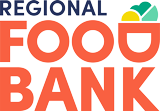
A pantry guest selects needed items with volunteer assistance at St. Vincent DePaul Church Food Pantry in Albany. Our partner pantries made small, manageable changes to increase safety measures while continuing to provide quality service and choice.
As the COVID-19 pandemic continues to present challenges, food insecurity remains a persistent issue.
With reduced incomes, supply chain disruptions, rising food costs, and pandemic benefits drawing to a close, many people are seeking food assistance – some for the very first time in their lives. Emergency feeding programs are aware of the needs in their communities and are answering the call.
Although some food relief organizations struggled to adjust to the multitude of forced revisions to their operations, there was an unexpected upside: coordinators and volunteers discovered ways to streamline food distribution. Utilizing client choice methods such as an inventory form, which pantry guests complete and submit prior to picking up their groceries, or online ordering software, which many can access via smartphone or computer, have proven beneficial to both guests and workers.
Many food pantries have increased outreach efforts to obtain volunteers and staff to provide delivery services to those with transportation or mobility issues. Many of our partner agencies anticipate this service will continue to grow. The pandemic also shed more light on the need for succession planning, which is vital to any organization today. In addition to developing disaster response plans, many programs have evaluated their organizational structures more closely and identified systems to ensure their doors stay open if there is an unexpected loss in support. Communication has increased as more workers delve deeper into social media and online video platforms. Technology has strengthened efficiency throughout our network, and many experts have offered to lend a hand at no expense.
These practices have allowed for positive change during a time of much hardship and uncertainty. They have provided families and individuals experiencing food insecurity with a greater level of comfort, and workers with new ways to work smarter.
“Coming together is a beginning; keeping together is progress; working together is success”
-Edward Everett Hale

